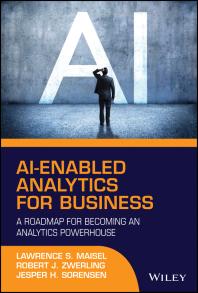 |
Learning Resource Centre Monthly Bulletin |
 |
 |
Learning Resource Centre Monthly Bulletin |
 |
| New Books |
 Ebook: EI 445 AI-Enabled Analytics for Business : A Roadmap for By Lawrence S. Maisel, Robert J. Zwerling, and Jesper |  Ebook: EI 446 Beyond the Realms : Navigating the Metaverse By Akashdeep Bhardwaj | Ebook: EI 447 Impact of Globalization and Advanced Technologies By Ree Chan Ho;Alex Hou Hong Ng;Mustafa Nourallah |
| Click Here to learn about the Recent Books added to our collection on different topics of Management. |
| Articles |
| Equilibrium analysis of live-streaming e-commerce supply chain in the AI era. By Liu, Shuai;Xu, Xiaoyan;Cheng, T. C. E. International Journal of Production Research. Nov2025, p1-19. 19p. 6 Illustrations. Abstract :Live-streaming e-commerce is an emerging online shopping channel that provides consumers with a satisfying shopping experience. This paper explores the operational and strategic implications of integrating artificial intelligence (AI) into live-streaming, focussing on the partial uncertainty elimination effect of AI avatar streamers and the full uncertainty elimination effect of real human streamers. We develop game-theoretical models to evaluate whether the retailer or the manufacturer should engage in AI and traditional live-stream selling under different selling modes, i.e. reselling mode and marketplace mode. We find that highly polarised AI costs, i.e. either extremely high or extremely low, and low human costs make it easier for the retailer to profit from AI live-stream selling under both selling modes. With high hassle costs, AI live-streaming`s pricing advantage weakens, and the retailer may lower prices to enhance its competitiveness. Interestingly, implementing AI live-streaming changes how commissions impact the choice of the selling mode in the context of live-streaming. Our results provide several practical managerial implications for effectively integrating AI into live-stream selling, ensuring that AI integration delivers tangible benefits in real-world settings. | |||
| The Role of AI Technologies in E-Commerce Development: A European Comparative Study. By Bocean, Claudiu George;Popescu, Luminița;Simion, Dalia;Sperdea, Natalița Maria Journal of Theoretical & Applied Electronic Commerce Research. Sep2025, Vol. 20 Issue 3, p225. 25p. Abstract : As global economies accelerate their digital transformation, artificial intelligence (AI) technologies have become a key driver of innovation and economic growth, especially in the electronic commerce sector. This study examines the impact of AI applications in marketing and sales on e-commerce performance across European economies, using official data from Eurostat. Our methodology includes factor analysis to identify underlying data structures, linear regression to explore causal relationships, generalized linear model (GLM) multivariate analysis to assess the combined effect of multiple factors, and cluster analysis to categorize countries based on their level of digitalization. Our results demonstrate a strong correlation between AI use and e-commerce performance, revealing two distinct clusters with unique characteristics. The findings reveal a positive association between the use of AI and firms` engagement in e-commerce activities, although the influence on turnover appears more limited. This suggests that while AI facilitates entry into the digital marketplace, financial performance depends on a broader set of factors, including technological infrastructure, market readiness, and strategic alignment. These insights provide a solid basis for developing policies and strategies that support digital transformation and technological innovation in Europe, helping to build competitive and sustainable economies. | |||
| AI-Driven Anomaly Detection in E-Commerce Services: A Deep Learning and NLP Approach to the Isolation Forest Algorithm Trees. By Mah, Pascal Muam;Skalna, Iwona;Pelech-Pilichowski, Tomasz Journal of Theoretical & Applied Electronic Commerce Research. Sep2025, Vol. 20 Issue 3, p214. 32p. Abstract :The accelerated development of e-commerce has given rise to sophisticated systems defined by significant user interaction, a variety of product offerings, and considerable quantities of structured and unstructured data. Upholding trust and operational security is becoming ever more essential. E-commerce platforms are susceptible to deceptive practices, including counterfeit reviews, dubious transactions, and anomalous usage behaviors. This research introduces a framework for anomaly detection powered by artificial intelligence, integrating deep learning and natural language processing (NLP) with the isolation forest algorithm tree to enhance the identification of unusual activities on e-commerce platforms. We leveraged customer feedback, transaction logs, and user interaction data obtained from Kaggle. Textual reviews were interpreted using natural language processing (NLP), while deep learning was utilized to discern behavioral patterns. The isolation forest algorithm tree was employed to detect statistical anomalies in multidimensional data. The hybrid model surpassed conventional techniques in terms of detection accuracy, recall, and interpretability. It successfully detects suspicious actions and clarifies anomalies in their relevant context. The application of AI techniques, particularly natural language processing, deep learning, and isolation forest algorithm trees, establishes a solid foundation for anomaly detection in the realm of e-commerce. This approach fosters a more secure and trustworthy experience for online consumers. | |||
| Do you wish to explore more articles? Just try using one of the full-text databases below! | |||
| Faculty - Click here to recommend new topics in E-biz/IT |
| News |
Wish to see more News? Click the link below: |